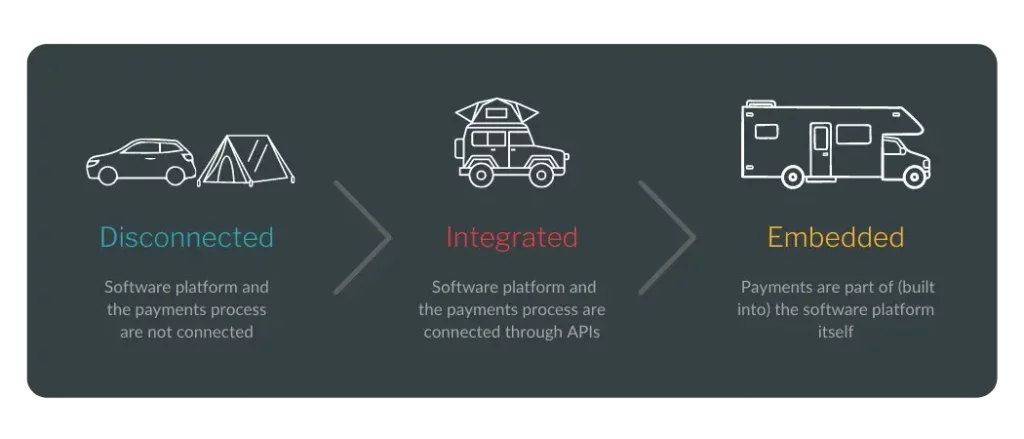Embedded finance is at the forefront of modern financial innovation, transforming how we interact with financial services in the digital age. 🚀 This concept combines financial services with all kinds of non-financial goodies, blending them seamlessly into e-commerce platforms and apps. Embedded Finance equips businesses with a competitive advantage, streamlining transactions, optimizing distribution, and providing access to invaluable data and resources.

- 12 October, 2023

Embedded finance is at the forefront of modern financial innovation, transforming how we interact with financial services in the digital age. 🚀 This concept combines financial services with all kinds of non-financial goodies, blending them seamlessly into e-commerce platforms and apps. Embedded Finance equips businesses with a competitive advantage, streamlining transactions, optimizing distribution, and providing access to invaluable data and resources.
How Embedded Finance Works?
Embedded finance is akin to the magician’s art, making the complex seem simple. It allows businesses to accept payments, provide insurance, or offer loans directly within their websites and apps. 📊 Customers purchase products or services without ever leaving the app, resulting in a streamlined and convenient transaction process.
Types of Embedded Finance
💡 Buy Now Pay Later (BNPL)
It’s a flexible payment option that allows customers to buy products or services and pay for them in interest-free or low-interest installments. It’s available across a wide range of retailers and eCommerce platforms, simplifying the checkout experience. For businesses, BNPL boosts sales, attracts younger customers seeking alternative payment methods, and streamlines financial operations.
💡 Embedded Insurance
It combines insurance with your regular shopping experience, automatically covering non-insurance products or services like cars, phones, or vacation packages. For instance, when you buy a car, you opt to include insurance as part of the deal. It helps businesses to open up an extra revenue stream and boost customer loyalty through hassle-free coverage. On the user side, it’s all about ease and peace of mind – no need to navigate the maze of standalone insurance purchases, and the security of knowing you’re covered.
💡 Embedded Investing
It’s all about blending investment opportunities with everyday services, sparing customers the hassle of a separate investment journey. For example, when you use your credit card, debit card, or digital wallet with cashback perks, you could invest those rewards in various assets. Even online shopping gets in on the act, letting customers invest in the stocks of the very companies whose products they’re buying.
💡 Embedded Payments
It integrates payment processing into third-party platforms and apps, allowing businesses to accept payments within their software or app without disrupting the user experience. For example, PayPal Checkout, Stripe Connect, and Square’s APIs offer such capabilities, making the checkout process easier.
Embedded payments are everywhere, revolutionizing user experiences across various industries. Let’s see where you can meet it:
🛒 E-Commerce Platforms: Amazon and Shopify users store payment info and complete purchases without leaving the site or app.
🚖 Ride-Sharing Apps: services like Uber embed payments, letting passengers pay directly through the app.
📺 Subscription Services: Netflix and Spotify manage recurring payments using embedded systems, simplifying billing.
🍔 Food Delivery Apps: customers order and pay in the same app.
👔 Freelance Platforms: clients pay through the platform, and freelancers receive funds without handling invoicing.
Don’t confuse it with Integrated Payments 💳
Integrated payments work within a single app or platform and connect with various systems like accounting, CRM, inventory management, and point-of-sale (POS) systems. They use APIs and SDKs for this magic, helping you avoid siloed data and manual entries. Now, here’s where embedded finance takes the spotlight – it goes beyond integrated payments. By linking payment processing with a broader range of business functions, it offers a more complete view of operations.

Perks of Embedded Finance
💸 Additional Income Channels: Businesses can tap into new revenue streams by incorporating financial services into their offerings.
🌟 User-Friendly Products: Streamlined user interfaces make products and services more appealing, improving the overall customer experience.
📈 Increased Conversions: Simplifying transactions leads to higher conversion rates, as customers are more likely to complete purchases.
📊 Valuable Customer Data: Embedded finance allows businesses to collect essential customer data, which can be used to enhance personalization and customer relationship management.
What's Next?
Embedded finance has the potential to reshape how financial providers engage with consumers. By embedding financial services into everyday transactions, businesses can simplify transactions, enhance the user experience, and unlock new opportunities for consumers. As this concept continues to evolve, we can expect to see even more innovative and exciting developments in the world of embedded finance, further solidifying its place in the future of finance and e-commerce.
Related Posts

How to Craft Your Startup’s Business Plan?

Turn The Idea into Million-Dollar Startup

MVP: Why It’s Crucial for Startup Success?
Have a project you would like to talk about?
info@codegeeks.solutions
108 Stryjska St, Lviv, Ukraine
+38 (093) 234 34 76






